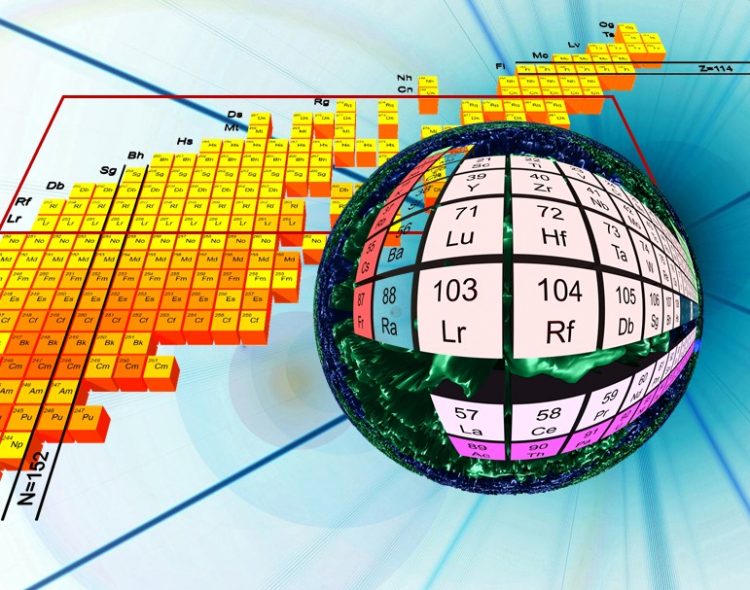Researchers present concept for a new technique to study superheavy elements

Laser resonance chromatography will initially be used to investigate lawrencium, element 103. Ill./©: Mustapha Laatiaoui
Superheavy elements are intriguing nuclear and atomic quantum systems that challenge experimental probing as they do not occur in nature and, when synthesized, vanish within seconds.
Pushing the forefront atomic physics research to these elements requires breakthrough developments towards fast atomic spectroscopy techniques with extreme sensitivity. A joint effort within the European Union's Horizon 2020 Research and Innovation program and led by Dr. Mustapha Laatiaoui from Johannes Gutenberg University Mainz (JGU) culminated in an optical spectroscopy proposal:
The so-called Laser Resonance Chromatography (LRC) should enable such investigations even at minute production quantities. The proposal has recently been published in two articles in Physical Review Letters and Physical Review A.
Superheavy elements (SHEs) are found at the bottom part of the periodic table of elements. They represent a fertile ground for the development of understanding on how such exotic atoms can exist and work when an overwhelming number of electrons in atomic shells and protons and neutrons in the nucleus come together.
Insights into their electronic structure can be obtained from optical spectroscopy experiments unveiling element-specific emission spectra. These spectra are powerful benchmarks for modern atomic-model calculations and could be useful, for example, when it comes to searching for traces of even heavier elements, which might be created in neutron-star merger events.
LRC approach combines different methods
Although SHEs have been discovered decades ago, their investigation by optical spectroscopy tools lack far behind the synthesis. This is because they are produced at extremely low rates at which traditional methods simply do not work. So far, optical spectroscopy ends at nobelium, element 102 in the periodic table.
“Current techniques are at the limit of what is feasible,” explained Laatiaoui. From the next heavier element on, the physicochemical properties change abruptly and impede providing samples in suitable atomic states.”
Together with research colleagues, the physicist has therefore developed the new LRC approach in optical spectroscopy. This combines element selectivity and spectral precision of laser spectroscopy with ion-mobility mass spectrometry and merges the benefits of a high sensitivity with the “simplicity” of optical probing as in laser-induced fluorescence spectroscopy.
Its key idea is to detect the products of resonant optical excitations not on the basis of fluorescent light as usual, but based on their characteristic drift time to a particle detector.
In their theoretical work, the researchers focused on singly charged lawrencium, element 103, and on its lighter chemical homolog. But the concept offers unparalleled access to laser spectroscopy of many other monoatomic ions across the periodic table, in particular of the transition metals including the high-temperature refractory metals and elements beyond lawrencium.
Other ionic species like triply-charged thorium shall be within reach of the LRC approach as well. Moreover, the method enables to optimize signal-to-noise ratios and thus to ease ion mobility spectrometry, state-selected ion chemistry, and other applications.
Dr. Mustapha Laatiaoui came to Johannes Gutenberg University Mainz and the Helmholtz Institute Mainz (HIM) in February 2018. In late 2018, he received an ERC Consolidator Grant from the European Research Council (ERC), one of the European Union's most valuable funding grants, for his research into the heaviest elements using laser spectroscopy and ion mobility spectroscopy. The current publications also included work that Laatiaoui had previously carried out at GSI Helmholtzzentrum für Schwerionenforschung in Darmstadt and at KU Leuven in Belgium.
This work was conducted in cooperation with Alexei A. Buchachenko from the Skolkovo Institute of Science and Technology and the Institute of Problems of Chemical Physics, both in Moscow, Russia, and Larry A. Viehland from Chatham University, Pittsburgh, USA.
Images:
https://download.uni-mainz.de/presse/09_chemie_him_optische_spektroskopie_01.jpg
Laser resonance chromatography will initially be used to investigate lawrencium, element 103.
Ill./©: Mustapha Laatiaoui
https://download.uni-mainz.de/presse/09_chemie_him_optische_spektroskopie_02.jpg
Laser resonance chromatography is based on optical excitations of ions and subsequent detection of their arrival at the detector.
Ill./©: Mustapha Laatiaoui
Related links:
https://www.hi-mainz.de/ – Helmholtz Institute Mainz
https://ec.europa.eu/programmes/horizon2020/en/what-horizon-2020 – Horizon 2020 – EU Research and Innovation program
https://www.lrc-project.eu/ – European LRC project
Read more:
https://www.uni-mainz.de/presse/aktuell/7246_ENG_HTML.php – press release “Mustapha Laatiaoui receives ERC Consolidator Grant for superheavy element research” (10 Jan. 2019)
https://www.uni-mainz.de/presse/20488_ENG_HTML.php – press release “First spectroscopic investigation of element nobelium” (29 Sept. 2016)
Dr. Mustapha Laatiaoui
Department of Chemistry
Johannes Gutenberg University Mainz
and
Helmholtz Institute Mainz
55099 Mainz
phone +49 6131 39-29752
e-mail: mlaatiao@uni-mainz.de
https://www.hi-mainz.de/research/research-sections/she-physics-chemistry-of-supe…
M. Laatiaoui, A. A. Buchachenko, L. A. Viehland, Laser resonance chromatography of superheavy elements, Physical Review Letters 125:2, 10 July 2020,
DOI: 10.1103/PhysRevLett.125.023002
https://journals.aps.org/prl/abstract/10.1103/PhysRevLett.125.023002
M. Laatiaoui, A. A. Buchachenko, L. A. Viehland, Exploiting transport properties for the detection of optical pumping in heavy ions, Physical Review A 102:1, 10 July 2020,
DOI: 10.1103/PhysRevA.102.013106
https://journals.aps.org/pra/abstract/10.1103/PhysRevA.102.013106
Media Contact
More Information:
https://www.uni-mainz.de/All latest news from the category: Life Sciences and Chemistry
Articles and reports from the Life Sciences and chemistry area deal with applied and basic research into modern biology, chemistry and human medicine.
Valuable information can be found on a range of life sciences fields including bacteriology, biochemistry, bionics, bioinformatics, biophysics, biotechnology, genetics, geobotany, human biology, marine biology, microbiology, molecular biology, cellular biology, zoology, bioinorganic chemistry, microchemistry and environmental chemistry.
Newest articles

Superradiant atoms could push the boundaries of how precisely time can be measured
Superradiant atoms can help us measure time more precisely than ever. In a new study, researchers from the University of Copenhagen present a new method for measuring the time interval,…

Ion thermoelectric conversion devices for near room temperature
The electrode sheet of the thermoelectric device consists of ionic hydrogel, which is sandwiched between the electrodes to form, and the Prussian blue on the electrode undergoes a redox reaction…

Zap Energy achieves 37-million-degree temperatures in a compact device
New publication reports record electron temperatures for a small-scale, sheared-flow-stabilized Z-pinch fusion device. In the nine decades since humans first produced fusion reactions, only a few fusion technologies have demonstrated…





















